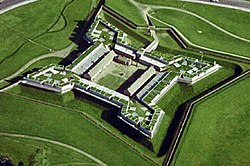Fort Stanwix
|
Fort Stanwix
|
|

Aerial view of the Fort Stanwix reconstruction
|
|
| Location | 112 E. Park St., Rome, New York |
|---|---|
| Coordinates | 43°12′38″N 75°27′18.9″W / 43.21056°N 75.455250°WCoordinates: 43°12′38″N 75°27′18.9″W / 43.21056°N 75.455250°W |
| Area | 16 acres (6.5 ha) |
| Built | 1758 |
| Visitation | 84,933 (2002) |
| Website | Fort Stanwix National Monument |
| NRHP Reference # | 66000057 |
| Significant dates | |
| Added to NRHP | October 15, 1966 |
| Designated NHL | November 23, 1962 |
| Designated NMON | August 21, 1935 |
Fort Stanwix was a colonial fort whose construction commenced on August 26, 1758, under the direction of British General John Stanwix, at the location of present-day Rome, New York, but was not completed until about 1762. The star fort was built to guard a portage known as the Oneida Carrying Place during the French and Indian War. Fort Stanwix National Monument, a reconstructed structure built by the National Park Service, now occupies the site.
Fort Stanwix was built to guard a portage between the main waterway southeastward to the Atlantic seacoast, down the Mohawk and Hudson rivers, and an important interior waterway northwestward to Lake Ontario, down Wood Creek and Oneida Lake to Oswego.
In 1768, Fort Stanwix was the site of an important treaty conference between the British and the Iroquois, arranged by William Johnson. By the time of this treaty, the fort had become dilapidated and inactive. The purpose of the conference was to renegotiate the boundary line between Indian lands and white settlements set forth in the Proclamation of 1763. The British government hoped a new boundary line might bring an end to the rampant frontier violence, which had become costly and troublesome. Indians hoped a new, permanent line might hold back white colonial expansion.
The final treaty was signed on November 5 and extended the earlier proclamation which happened much further west. The Iroquois had effectively ceded Kentucky to the whites. However, the Indians who actually used the Kentucky lands, primarily Shawnee, Delaware, and Cherokee, had no role in the negotiations. Rather than secure peace, the Fort Stanwix treaty helped set the stage for the next round of hostilities.
...
Wikipedia


